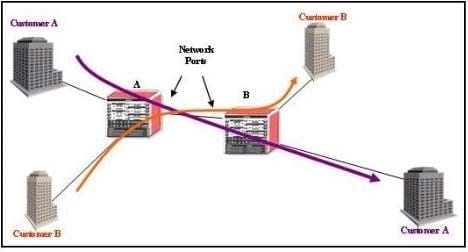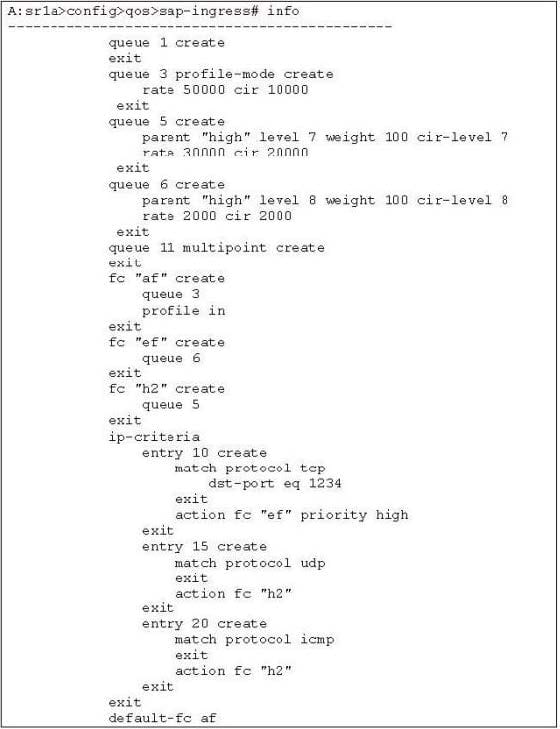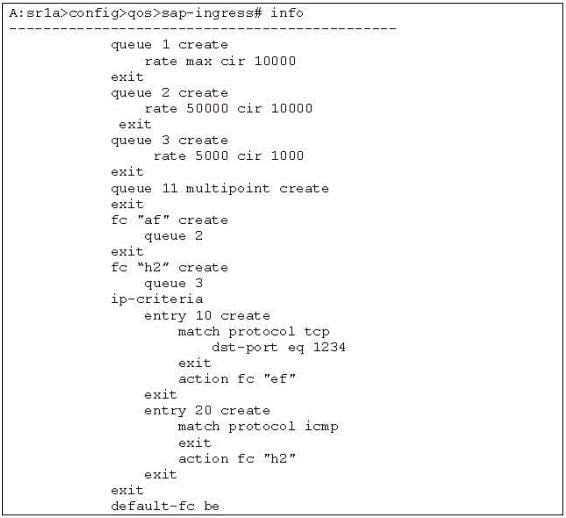Exam Details
Exam Code
:4A0-107Exam Name
:Nokia Quality of ServiceCertification
:Nokia CertificationsVendor
:NokiaTotal Questions
:212 Q&AsLast Updated
:Apr 13, 2025
Nokia Nokia Certifications 4A0-107 Questions & Answers
-
Question 141:
Click the exhibit button below. Each router is interconnected by a single GigE link, as shown in the diagram below.

Note: The arrows show the direction of traffic flow.
Traffic from Customer A and Customer B that is classified to the same forwarding class is queued together at the ingress of Router B.
A. True
B. False
-
Question 142:
A queue is configured with the following attributes:
MBS = 10KB CBS = 5KB High-Priority-Only = 30%
Assume that there is no CBS overbooking and that the slope-policy is disabled. If the current queue depth is 8KB, what will happen to an in-profile packet arriving in the queue?
A. It will be discarded because the high-priority-only threshold is exceeded.
B. It will be queued but re-marked as "out-of-profile."
C. It will be queued in the reserved portion of the buffer pool and remain "in-profile."
D. It will be queued in the shared portion of the buffer pool but contend for shared buffer space with packets from other queues.
E. It will be queued in the shared portion of the buffer pool but may be dropped if the buffer utilization exceeds the start-average value of the low slope.
-
Question 143:
On the Nokia 7750 SR, how many queues per FC are available for multipoint traffic within a VPLS on service ingress?
A. 64
B. 8
C. 3
D. 16
E. 1
-
Question 144:
On the Nokia 7750 SR, what is a slope policy used for?
A. Defining the slope of the TCP slow-start mechanism for self generated traffic.
B. Defining the slope of the scheduling rate per forwarding class when using HQoS.
C. Defining the high and low slope values when deploying buffer admission control for UDP traffic in the committed buffer pool.
D. Defining the high and low slope values when deploying buffer admission control for TCP traffic in the shared buffer pool.
E. Defining the high and low slope values when deploying buffer admission control for TCP traffic in the committed buffer pool.
-
Question 145:
Click the exhibit button below. Given the SAP-ingress policy, which of the following statements are TRUE? (Choose three)

A. All AF traffic will be marked "in-profile" at the SAP-ingress.
B. All TCP traffic will be mapped to forwarding class EF.
C. UDP traffic is placed in queue 3 while ICMP traffic is placed in queue 5.
D. EF traffic will receive higher scheduling priority than H2 traffic.
E. Traffic that does not match any of the IP criteria will be placed in queue 3.
-
Question 146:
Which of the following statements regarding buffer pool allocation are FALSE? (Choose two)
A. Each network egress port receives its own buffer pool.
B. Each SAP-egress port receives its own buffer pool.
C. All SAP-ingress ports on the same MDA share a buffer pool.
D. All the network ingress ports on the same MDA share a buffer pool.
E. Each network ingress port on the same MDA receives its own buffer pool.
-
Question 147:
Which of the following statements is considered best practice when changing a network policy that has been associated with an interface?
A. The policy should be placed in a "shutdown" state before changes are made.
B. A new network policy should be created and applied to the interface, overwriting the previous policy.
C. The policy must first be removed from the interface, then modified and re-applied to the interface.
D. Before the policy can be changed, it must be deleted with the no network qos
command. E. Before any changes are made to the policy, all network interfaces where the policy is applied have to be shut down.
-
Question 148:
Which of the following are possible criteria for classifying packets at the SAP-ingress? (Choose three)
A. The EXP bits in the MPLS header.
B. The packet's source and destination IP addresses.
C. The service ID of the service to which the SAP belongs.
D. The dot1p bits in the frame header.
E. The packet's Ethertype.
-
Question 149:
Click the exhibit button below. A network operator has configured the SAP-ingress policy below. Ping traffic is expected in queue 3. However, the network operator notices that all traffic is placed in queue 1. What is the most probable reason for this?

A. The default forwarding class for all traffic, including ICMP, is BE, which is placed in queue 1.
B. The SAP has been shut down.
C. The IP-match criteria has been misconfigured for ICMP traffic.
D. Queue 3 has no rate or CIR configured and thus cannot hold any packets.
E. The SAP-ingress policy has not been applied to the SAP.
-
Question 150:
Without_______, a customer's high priority traffic can be dropped before its low priority traffic.
A. packet filtering
B. prioritization of traffic flows
C. least cost routing
D. OAM functionality
E. separation between the data plane and the control plane
Related Exams:
4A0-100
Nokia IP Networks and Services Fundamentals4A0-101
Nokia Interior Routing Protocols4A0-102
Nokia Border Gateway Protocol for Internet Routing4A0-103
Nokia Multiprotocol Label Switching4A0-104
Nokia Services Architecture4A0-105
Nokia Virtual Private LAN Services4A0-106
Nokia Virtual Private Routed Networks4A0-107
Nokia Quality of Service4A0-108
Nokia Multicast Protocols4A0-109
Alcatel-Lucent Triple Play Services
Tips on How to Prepare for the Exams
Nowadays, the certification exams become more and more important and required by more and more enterprises when applying for a job. But how to prepare for the exam effectively? How to prepare for the exam in a short time with less efforts? How to get a ideal result and how to find the most reliable resources? Here on Vcedump.com, you will find all the answers. Vcedump.com provide not only Nokia exam questions, answers and explanations but also complete assistance on your exam preparation and certification application. If you are confused on your 4A0-107 exam preparations and Nokia certification application, do not hesitate to visit our Vcedump.com to find your solutions here.